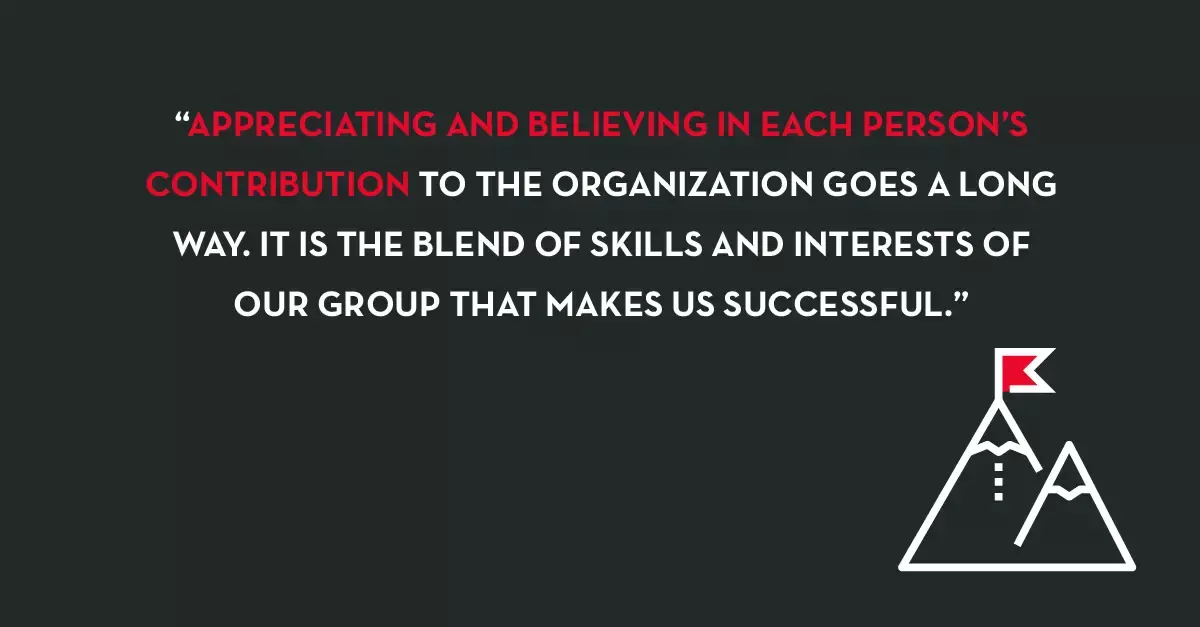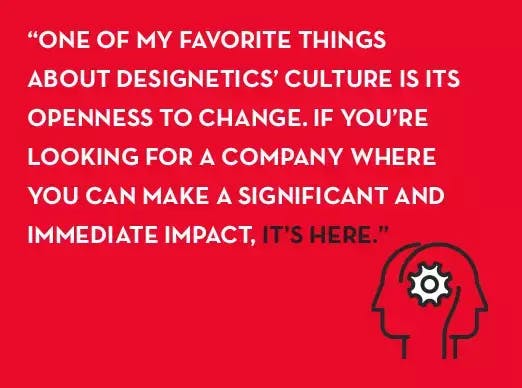How long have you worked at Designetics?
I worked for a few months as an intern while I was studying for my bachelor’s degree. I have been working here full-time for four years.
Did you start in your current role or were you working in another capacity at Designetics?
My internship was in marketing. Since I started working full-time, I have been in Human Resources (HR).
What are the biggest challenges providing human resources services to employees at Designetics?
It is important to me to recognize that each person is different and has evolving goals and needs at work. To maintain that individualized approach while creating and maintaining effective practices for the entire group requires constant evaluation and creativity. Since Designetics’ success is based on its people— people whose lives change daily in small ways and in significant ways over time—I encourage management to embrace the fluctuating needs of our workforce and to harness that natural progression to further Designetics’ objectives. If we are having a challenge with something, it means that there is an opportunity for new ideas and growth.

How do you motivate a workforce to perform their best?
Appreciating and believing in each person’s contribution to the organization goes a long way. It is the blend of skills and interests of our group that makes us successful. For example, I do not think anyone’s goals on their performance appraisals are the same: everyone has different ideas for how they can help Designetics. Managers are supportive but firm in their expectations of their direct reports, and I have the privilege to participate in the process where employees brainstorm goals and take practical steps to accomplish them.
How has the HR field changed over the years?
Since I am somewhat new to human resources, I do not have a lot of personal reference for how HR has evolved. From what I have learned from other professionals, the focus in HR has shifted from administrative transactions and policy enforcement to creating workplace cultures that support evolving business objectives. If we want to be effective, we must be analytical and strategic so that we can empower our employees and stay competitive.
Have you seen a shift in the way all companies regard the human resource function? If so, how?
A few years ago, it was a reoccurring theme at HR conferences and trainings that we needed to demand more inclusion in organizational strategy. This type of theme seems to have changed, which I think is largely due to how competitive the job market is. Companies are struggling with hiring and retention and are realizing that their employees are their most important asset. Unemployment is lower, people have options for where they can work, and workplace cultures are much more public.
Other departments look to human resources for answers. What kind of an organizational structure will keep talented employees happy? How do you fill vacant positions when most qualified candidates already have a job? How do you train your existing employees to meet changing demands? These are complicated and widespread challenges, but human resources departments specialize in this kind of work.
What types of human resources challenges present themselves when a company is in rapid growth mode?
Since our workforce is growing, it is vital that managers effectively oversee their department’s personnel and processes. I appreciate that managers’ responsibilities require increasingly demanding technical and interpersonal skills, so a huge part of our time in HR is spent with managers: answering their questions; participating in performance conversations; and ensuring that they have access to internal and external training opportunities. Strong leadership has made our continued growth possible because managers support their developing teams.
What is your approach to recruiting employees?
We have the most success in hiring when our initiatives align with the goals of candidates. Instead of focusing on filling positions based on our existing job requirements, we ask: where do we see ourselves in the future and who do we need to get there? Sometimes, this means that we hire employees with nontraditional education or job experiences. We focus primarily on people’s skills and whether they want to move in the same direction as us.
How has recruitment changed over the years?
When I started in HR, you could still see the aftereffects of the recession. There were a lot of people searching for jobs, so we used to be able to post jobs in newspapers or on job boards and easily find qualified, interested candidates. Now with a more competitive job market, we need to be more creative. Casey Clark (our Human Resources Generalist) and I are always trying new methods to advertise positions and assess candidates’ skills. We’ve even considered how artificial intelligence could help with identifying candidates, but that technology is so new to the market that it’s not a viable option for us yet.
What advice would you give job seekers who want to work at Designetics?
One of my favorite things about Designetics’ culture is its openness to change. If you’re looking for a company where you can make a significant and immediate impact, it’s here. Employees have a lot of opportunities to create initiatives and to see their projects through from start to finish without needing to jump through hoops. If you have an idea and you’re willing to put in the work for it, you’re encouraged to go for it.
How do you ensure employees are onboarded the right way?
We put a lot of time and emphasis on training. When possible, one thing that we have a lot of success with is asking for volunteers to train. It’s a big responsibility, so we want people to feel prepared for it. I can’t tell you how many conversations I’ve had with trainers who are trying to brainstorm ways to help their trainees understand something. Our trainers care about the success of their people, and it is much easier for new hires to acclimate to their jobs when people are rooting for them.
What types of policies and procedures are put in place to ensure Designetics keeps up with changing cultures and norms?
Everything we do is built on our company values: “integrity and honesty, respect is key, and attention to detail.” By doing what is right and respecting each other, we are always ready to listen and embrace new ideas. Since we strive to provide the highest quality of services—from the big picture to the small details—we constantly evaluate what we offer to ensure that we provide what our customers and employees require for their success. Our culture is focused on continuous improvement. That is what makes what we do so rewarding…and that is what will ensure our relevance among social changes.
Where do you see the human resources field going in the next ten years?
With so many technological advances, it is tempting to say that the role of HR will become coldly data-driven and automated. That might be true if the purpose of HR was to complete paperwork and repeated tasks, but that’s not the reality.
Most of the people I meet want a good manager, training from a real person, clear communications and someone to talk to. Most managers want support with areas that are outside of their specialty, especially when it comes down to challenges that are intricately human. As everyone advances in technical capabilities, if there’s going to be a gaping hole, it’s going to be in meaningful and effective human interaction and processes, which is the core function of human resources. So, while I do feel it is necessary in the upcoming years to embrace new technology, the key will be to leverage it to increase effectiveness of people management.
